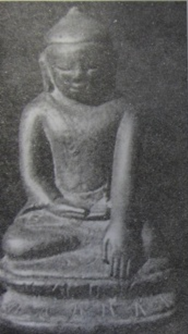Chapter outline and page reference:
Introduction 181
Intwa 185
Lakha Medi and the Great Boria Stupa 188
Some Further Ancient Sites at Girnar 199
Rathakot 199
Suraj Kund 200
Ramnath 202
Hajam Chora 202
Laxman Tekri 202
Mathura 202
Jogania Hill 202
Gadhesing-ka-Dongar 205
Chapter preview (first three pages only):
Figure . Two 7th/8th century, copper alloy images of seated meditative Buddha in bhumisparsha mudra, from Junagadh, in the Junagadh Museum. Left: 8cm x 5cm x 3cm. Right: 9cm x 7cm x 4cm (from Bhowmik 1995).
Introduction
Girnar has special significance for Buddhism, since there is strong evidence that the relic found within Lakha Medi or the Great Boria Stupa, near the Bordevi Temple in the southern valley of the Girnar Compound, is that of the Buddha, the originator of a significant world religion. There is therefore very good reason for this neglected site to receive careful attention, conservation and promotion as an important site of pilgrimage interest for both national and international spiritual tourists.
Mitra (1971, page 141) pointed out that: ‘the early Buddhist affiliation of the area around Girnar is beyond doubt.’ Mishra (2006, page 57) noted that: ‘The concentration of Buddhist sites at the Girnar hill and its surrounding area seems to have been economically viable to be able to support a large number of monks living in and around modern day Junagadh. The establishment of Khapara Kodia was by no means small, and when taken together with the Bawa Pyara caves as well as the vihara at Intwa, it is clear that this area had a strong Buddhist presence, not seen elsewhere in Gujarat.’
The edicts of Ashoka on the way to Mount Girnar furnish us with the earliest evidence of the existence of Buddhism in Saurashtra. Sankalia (1941, page 229) suggested that ‘…during the Indo-Greek occupation of Kathiawar and Southern Gujarat or during the Ksaharata regime, the religion flourished in the whole of Western India.’ Sankalia continued: ‘we know from the inscriptions of the kings of Valabhi and the accounts of the Chinese travellers Hiuen Tsiang and I-Tsing that both Hinayana and Mahayana flourished there for about 250 years (c. 520 A.D.–770 A.D.)…The epigraphs show that from King Dhruvasena I onwards, every Valabhi king upto Siladitya VII (c. 770 A.D.) actively patronised Buddhism’. Gadre (1939) noted that: ‘There are grounds to believe that Buddhism had penetrated into Saurashtra or Kathiawad even before Asoka’s time. While speaking about Fa-la-pi or Valabhi, Hieun Tsang remarks “When Tathagata lived in the world, he often travelled through this country. Hence Asokaraja raised monuments or built Stupas in all places where Buddha rested” [see Beal 1884, page 267].’ On the other hand, Dikshit (1946) commented that: ‘The legendary accounts therefore such as credit Buddha’s visit to Western India, have to be summarily rejected as Buddha is never known to have crossed the Narbada river’.
When Yuan Chwang visited western India, everywhere he found monasteries and followers of the Hinayana Sammatiya and Mahayana Sthavira Schools. Although the former was more powerful, and dominated in places like Sindh, Cutch and Valabhi, the Sthavira School was stronger in Junagadh. Buddhism disappeared from Valabhi in the 8th century when it was destroyed by the Arabs. The religion probably did not linger long in the rest of Saurashtra. Ray (2004b) pointed out that: ‘Buddhism largely disappeared from India in the early medieval period, though it continued to flourish in Gujarat until the ninth century.’ Majmudar (1963) commented that: ‘With the rise of Neo-Brahmanism preached by Sri Sankaracarya by the end of the eighth century A.D., Buddhism lost its hold in Gujarat; but it lingered up to the beginning of the eleventh century A.D., as can be noticed from the scant material remains of Buddhism found in Gujarat.’
Tirmizi (1968, page 3) commented on early Buddhism in Saurashtra: ‘we find Yavana Dharmaraksta as the Buddhist evangelist, sent by Asoka (273-240 B.C.) to preach Buddhism to the people of Saurashtra.’ Indraji and Jackson (1896, page 13) also remarked on this topic: ‘…Asoka (B.C. 230) the great Mauryan king and propagator of Buddhism chose, among the Buddhist Theras sent to

